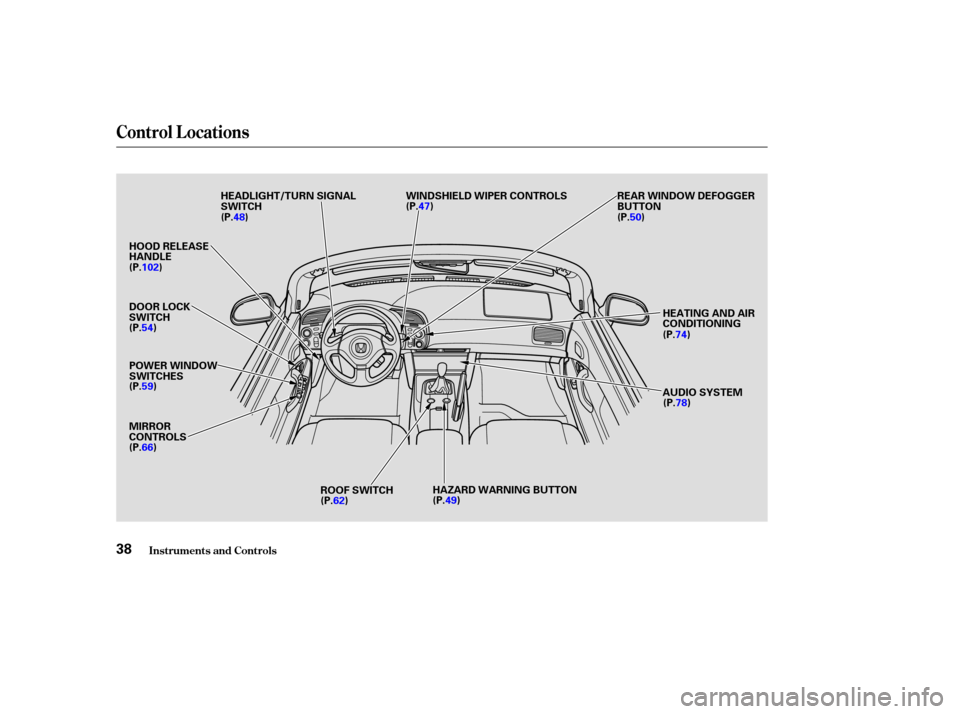air condition HONDA S2000 2004 2.G Owners Manual
[x] Cancel search | Manufacturer: HONDA, Model Year: 2004, Model line: S2000, Model: HONDA S2000 2004 2.GPages: 208, PDF Size: 2.91 MB
Page 5 of 208

Your Vehicle at a Glance
2
HEADLIGHTS/TURN SIGNAL SWITCH
HOOD RELEASE
HANDLE
DOOR LOCK
SWITCH
POWER WINDOW
SWITCHES
MIRROR
CONTROLSROOF SWITCH AUDIO SYSTEM
HEATING AND AIR
CONDITIONING
REAR WINDOW DEFOGGER
BUTTON
WINDSHIELD WIPER CONTROLS
HAZARD WARNING BUTTON
(P.48)
(P.102)
(P.54) (P.59)
(P.66) (P.47)
(P.50)
(P.74)
(P.78)
(P.49)
(P.62)
Page 9 of 208

You’ll f ind many saf ety
recommendations throughout this
section, and throughout this manual.
Therecommendationsonthispage
are the ones we consider to be the
most important.
A seat belt is your best protection in
all types of collisions. Airbags
supplement seat belts, but airbags
are designed to inf late only in a
moderate to severe f rontal collision.
So even though your vehicle is
equipped with airbags, make sure
you and your passenger always wear
your seat belts, and wear them
properly. (See page ).
Since all children are saf est in the
back seat of a vehicle, and your
vehicle does not have a back seat, we
recommend that you do not carry achild passenger.
If a small child who must be
restrained in a f orward-f acing child
seat, or a larger child, must ride in
this vehicle, be sure to f ollow all
instructions and saf ety warnings in
this manual (see pages and ).
While airbags can save lives, they
can cause serious or fatal injuries to
occupants who sit too close to them,
or are not properly restrained.
Inf ants, young children, and short
adults are at the greatest risk. Be
sure to f ollow all instructions and
warnings in this manual.
Alcohol and driving don’t mix. Even
one drink can reduce your ability to
respond to changing conditions, and
your reaction time gets worse withevery additional drink. So don’t drink
and drive, and don’t let your f riends
drink and drive, either.
Excessive speed is a major f actor in
crash injuries and deaths. Generally,
the higher the speed, the greater the
risk, but serious injuries can also
occur at lower speeds. Never drive
f aster than is saf e f or current
conditions, regardless of the
maximum speed posted.
Having a tire blowout or a
mechanical f ailure can be extremely
hazardous. To reduce the possibility
of such problems, check your tire
pressures and condition f requently,
and perform all regularly scheduled
maintenance (see page ).
26
12 30
121
Important Saf ety Precautions
Driver and Passenger Saf ety
Always Wear Your Seat Belt
Your Vehicle is Not
Recommended f or Child
Passengers Be Aware of Airbag Hazards
Don’t Drink and DriveControl Your Speed
K eep Your Vehicle in Saf e
Condition
Due to the
passenger’s airbag hazard, you should never carry an inf ant in arear-f acing child seat in t his vehicle.
6
Page 20 of 208

The tensioners are designed to
activate primarily in f rontal collisions,
andtheyshouldactivateinany
collision severe enough to cause
airbag inflation.
However, the tensioners can be
activated during a collision in which
the airbags do not deploy. In this
case, the airbags would not be
needed, but the additional restraint
could be helpf ul.
When the tensioners are activated,
the seat belts will remain tight until
they are unbuckled in the normal
manner.For saf ety, you should check the
condition of your seat belts regularly.
Pull each belt out f ully and look f or
f rays, cuts, burns, and wear. Check
that the latches work smoothly and
the belts retract easily. Any belt that
is not in good condition or not
working properly will not provide
good protection and should be
replaced as soon as possible.
Acura provides a lif etime warranty
on seat belts f or U.S. models. See
your
booklet f or details.
If a seat belt is worn during a crash,
it must be replaced by the dealer. A
belt that has been worn during a
crash may not provide the same level
of protection in a subsequent crash.The dealer should also inspect the
anchors f or damage and replace
them if needed. If the automatic seat
belt tensioners activate during a
crash, they must be replaced.
For inf ormation on how to clean your
seat belts, see page .
143
Acura Warranty Inf ormation
Additional Inf ormation About Your Seat Belts
Driver and Passenger Saf ety
Seat Belt Maintenance
17
Not checking or maintaining
seat belts can result in serious
injury or death if the seat belts
do not work properly when
needed.
Check your seat belts regularly
and have any problem
corrected as soon as possible.
Page 37 of 208

Your vehicle’s exhaust contains
carbon monoxide gas. You should
have no problem with carbon
monoxide entering the vehicle in
normal driving if you maintain your
vehicle properly.
Have the exhaust system inspected
f or leaks whenever:The vehicle is raised f or an oil
change.
You notice a change in the sound
of the exhaust.
The vehicle was in an accident
that may have damaged the under-
side. High levels of carbon monoxide can
collect rapidly in enclosed areas,
such as a garage. Do not run the
engine with the garage door closed.
Even with the door open, run the
engine only long enough to move the
vehicle out of the garage. With the trunk lid open, air f low can
pull exhaust gas into your vehicle’s
interior and create a hazardous
condition. If you must drive with the
trunk lid open, open all the windows,
and set the heating and cooling
system as shown below.
If you must sit in your parked vehicle,
even in an unconf ined area, with the
engine running, adjust the heating
and cooling system as f ollows:
Push the button.
Select the mode.
Turn the f an on high speed.
Set the temperature control to a
comfortable setting.
1.
2.
3.
4.
Carbon Monoxide Hazard
Driver and Passenger Saf ety34
Carbon monoxide gas is toxic.
Breathing it can cause
unconsciousness and even kill
you.
Avoid any enclosed areas or
activities that expose you to
carbon monoxide.
Page 41 of 208

Control L ocations
Inst rument s and Cont rols38
HEADLIGHT/TURN SIGNAL
SWITCH
HOOD RELEASE
HANDLE
DOOR LOCK
SWITCH
POWER WINDOW
SWITCHES
MIRROR
CONTROLS
ROOF SWITCH AUDIO SYSTEM
HEATING AND AIR
CONDITIONING
REAR WINDOW DEFOGGER
BUTTON
WINDSHIELD WIPER CONTROLS
HAZARD WARNING BUTTON
(P.48)
(P.102)
(P.54)
(P.59)
(P.66) (P.47)
(P.50)
(P.74)
(P. 78)
(P.49)
(P.62)
Page 76 of 208

The heating and air conditioning
systems in your Honda provide a
comf ortable driving environment in
all weather conditions.
The standard audio system has
many f eatures. This section de-
scribes those f eatures and how to
use them. (If you selected an
optional audio system, ref er to the
operating instructions that came
with it.)...............
Vents, Heating, and A/C . 74
...............................
Airflow Buttons .75
............................
Playing the Radio .78
..............................
Radio Reception .81
....................................
Playing a CD .83
.....................................
CD Changer .84
......................
Protecting Your CDs .85
...........
CD Player Error Messages . 86
.......
CD Changer Error Messages . 87
...
Playing the XM
Satellite Radio . 88
..................
Remote Audio Controls . 93
...................
Radio Thef t Protection . 94
.................................
Cruise Control .95
Comf ort and Convenience Features
Comf ort and Convenience Feat ures73
Page 77 of 208

Vents, Heating, and A/C
Comf ort and Convenience Feat ures74
RECIRCULATION
BUTTON
AIR CONDITIONING
BUTTON
FAN CONTROL LEVER MODE CONTROL DIAL
TEMPERATURE
CONTROL DIAL
Page 78 of 208

Push this lever up and down to
increase and decrease the f an speed.
The indicators next to the lever show
you the speed selected.
Turning this dial clockwise increases
the temperature of the airflow.
This button turns the air
conditioning on and of f . The
indicator in the button comes on
when the A/C is on.
This button controls the source of
the air going into the system. When
the indicator in this button is on, air
f rom the vehicle’s interior is sent
through the system again
(Recirculation mode). When the
indicator is of f , air is brought in f rom
outside the vehicle (Fresh Air mode).The outside air intakes f or the
heating and cooling system are at
the base of the windshield. Keep this
area clear of leaves and other debris.
ThesystemshouldbeleftinFresh
Air mode under almost all conditions.
Keeping the system in Recirculation
mode, particularly with the A/C of f ,
can cause the windows to fog up.
Switch to Recirculation mode when
driving through dusty or smoky
conditions, then return to Fresh Air
mode.
This button turns the rear window
def ogger of f and on (see page ).
Use the mode control dial to select
the vents the air flows from. Some
air will f low f rom the dashboard
vents in all modes. Air flows from the vents on
both sides of the instrument panel,
andfromthedashboardventinfront
of the passenger.
Airf low is divided between
the vents in the dashboard and the
f loor vents.
Air flows from the center
vents in the dashboard above the
audio system, the vents on both
sides of the instrument panel, and
f rom the f loor vents. Select this
position when you drive with the
convertible top f olded.
Air f lows f rom the f loor
vents and the vents on both sides of
the instrument panel.
Airf low is divided between
the f loor vents and the def roster
vents at the base of the windshield,
and the vents on both sides of the
instrument panel.
50
Comf ort and Convenience Feat ures
Fan Control L ever
T emperature Control Dial
Air Conditioning (A/C) Button
Recirculation Button
Rear Window Def ogger Button
Mode Control Dial
Airf low Buttons
75
Page 79 of 208

The f low-through ventilation system
draws in outside air, circulates it
through the interior, then exhausts it
through vents behind the seat-backs.Turn the temperature control dial
all the way to the lef t.
Make sure the A/C is of f .
Select and Fresh Air mode.
Set the f an to the desired speed.
The heater uses engine coolant to
warm the air. If the engine is cold, it
will be several minutes bef ore you
f eel warm air coming f rom the
system. Select and Fresh Air mode.
Set the f an to the desired speed.
Adjust the warmth of the air with
the temperature control dial. Air conditioning places an extra load
on the engine. Watch the engine
coolant temperature gauge (see page
). If it moves near the red zone,
turn of f the A/C until the gauge
reads normally.
Turn on the A/C by pressing the
button. The indicator in the button
comesonwhenafanspeedis
selected.
Make sure the temperature
control dial is all the way to the left.
Select .
If the outside air is humid, select
Recirculation mode. If the outside
air is dry, select Fresh Air mode.
Set the f an to the desired speed. you can
cool it down more rapidly by partially
opening the windows, turning on the
A/C, and setting the fan to
maximum speed in Fresh Air mode.
Air f lows f rom the def roster
vents at the base of the windshield
and the vents on both sides of the
instrument panel.
When you select , the system
automatically switches to Fresh Air
mode and turns on the A/C. 1.
2.
3.
4.
1.
2.
3.1.
2.
3.
4.
5.45
If the interior is very warm,
Ventilation
Using the Heater
Using the A /C
Comf ort and Convenience Feat ures
Vents, Heating, and A/C
76
Page 80 of 208

To remove f og f rom the inside of the
windows:
When you switch to another mode
f rom , the A/C stays on.
Press the A/C button to turn it of f .Select . The system
automatically switches to Fresh
Air mode and turns on the A/C.
Select .
Set the f an and temperature
controls to the maximum level.
Air conditioning, as it cools, removes
moisture from the air. When used in
combination with the heater, it
makes the interior warm and dry.
Switch the f an on.
Turn on the air conditioning.
Select and Fresh Air mode.
Adjust the temperature control
dial to your pref erence.
This setting is suitable f or all driving
conditions whenever the outside
temperature is above 32°F (0°C). Set the f an to the desired speed.
Select . When you select
, the system automatically
switches to Fresh Air mode and
turns on the A/C.
Adjust the temperature control
dial so the airflow feels warm.
Select to help clear the
rear window. To clear the windows f aster, you can
close the dashboard corner vents
and the vents on both sides of the
instrument panel by rotating the
wheel below the vent. This will send
more warm air to the windshield
def roster vents. Once the windshield
is clear, select the Fresh Air mode to
avoid f ogging the windows.
For your saf ety, make sure you have
a clear view through all the windows
bef ore driving.
1.
2.
3.
4.
1.
2.
3.
4.1.
2.
3.
Vents, Heating, and A/C
Comf ort and Convenience Feat ures
T o Def og and Def rost
T o Remove Exterior Frost or Ice
From the Windows
To Dehumidif y the Interior
77